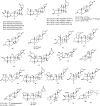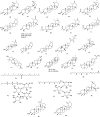A review on phytochemical constituents and pharmacological potential of Calotropis procera
- PMID: 35492791
- PMCID: PMC9043578
- DOI: 10.1039/d1ra06703f
A review on phytochemical constituents and pharmacological potential of Calotropis procera
Abstract
Calotropis procera is locally known as Aak or Madar in Hindi, milk weed in English and belongs to the family Apocynaceae and subfamily Asclepiadoideae. Although a wasteland plant, it is of sacred use as its flowers are offered for worshipping Lord Shiva, a Hindu God. Tribes all over the world use the plant in treatment of various diseases like snake bite, body pain, asthma, epilepsy, cancer, sexual disorders, skin diseases and many more. This plant contains various phytoconstituents such as flavonoids, terpenoids, cardenolides, steroids oxypregnanes etc. Though literature searches reveal many reviews about ethnomedicinal uses, chemical composition and pharmacological activities, no recent papers are available that provide an overview of the therapeutic potential and toxicity of Calotropis procera. Hence, the insight of this review is to provide a systemic summary of phytochemistry, pharmacology, toxicology and therapeutic potential of Calotropis procera and to highlight the gaps in the knowledge so as to offer inspiration for future research.
This journal is © The Royal Society of Chemistry.
Conflict of interest statement
The authors confirm that this article content has no conflict of interest.
Figures














References
-
- Joshi M. C. Patel M. B. Mehta P. J. Bull. Med.-ethno-bot. Res. 1980;1:8–24.
-
- Chandra K. Pandey U. N. Some folk medicines of Singhbhum (Bihar) Sachitra Ayurveda. 1984;37:253–357.
-
- Bhatnagar L. S. Singh V. K. Pandey G. J. Res. Indian Med. 1973;8(2):67–100.
-
- Venkateswarulu J., Bhairavamurthy P. V. and Rao N., The Flora of Visakhapatnam, Andhra Pradesh Academy of Sciences, Hyderabad, 1972, p. 128
Publication types
LinkOut - more resources
Full Text Sources

